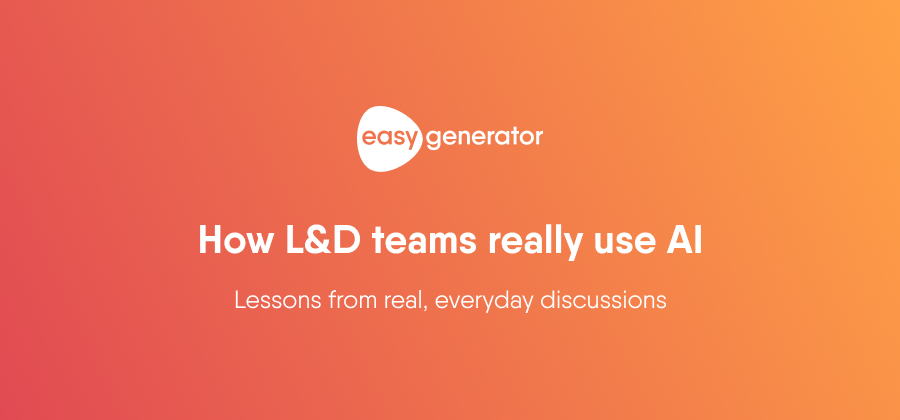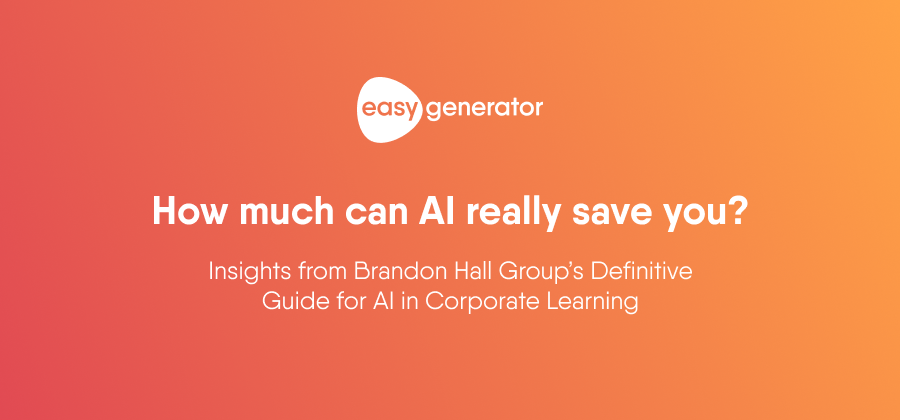Alexandra Hemmer is a copywriter at Easygenerator. Originally from Singapore, she spent her higher education years in the U.S. where she kickstarted a career in content marketing and journalism. She currently resides in the Netherlands, embracing her Dutch-Indonesian roots.
What is video-based learning? The future of learning explained
Video is quickly becoming the standard e-learning format. In 2021, YouTube was reported to be the second most visited website after Google with over 2 billion users. But what makes video-based learning so engaging? We’ll explore its definition, some examples, benefits, and more.

What is video-based learning?
Video-based learning literally refers to learning experiences facilitated through video. With its ability to combine camera footage, animation, graphics, text, and audio, videos create a multisensory learning experience, unlike any other e-learning format. Because of this, it’s no surprise that video-based learning is quickly becoming a dominant standard of online training. As mentioned earlier, YouTube alone boasts 2 billion users worldwide. That’s approximately a third of the internet.
But it’s not just a trend. When it comes to corporate training, research has shown that there are several benefits to opting for video, including improved learner retention rates. We’ll take a closer look at the benefits later. First, let’s look at some examples of video-based learning.
Video-based learning examples
Video-based learning comes in many different formats that serve unique purposes. Here are some real-life examples of video-based learning today:
-
Animated explainers
Apart from being visually appealing, animated videos are also effective for illustrating complex or abstract topics that would otherwise be harder to convey. This makes it easier for learners to process the information as well. For example, the German YouTube channel, Kurzgesagt, has earned over a billion views for its animated videos that teach various complex subjects, including philosophy, biology, and physics.
-
Expert-led explainer videos
Expert advice is always valuable. But when it’s delivered by the experts themselves in the form of an explainer video, it creates an inviting experience that emulates a lecture or even one-on-one instruction. Once again, YouTube is filled with expert-led channels covering almost any subject users might need.
-
Interactive videos
Video-based learning doesn’t have to be a passive experience. Adding interactive elements can create an immersive experience where learners can impact the content based on their decisions. For example, some compliance training programs use scenarios where learners can participate as a character in the narrative and make decisions based on their compliance knowledge.
Benefits of video-based learning
Aside from knowing what video-based learning is, it’s important to understand why it’s so beneficial. Here are some key benefits of video-based learning:
-
It improves learner retention
Videos are made up of a variety of elements, from visual and audio effects to interactive activities that require users to click or type responses. Because of this, videos can engage learners through multiple senses, which not only creates a more stimulating experience but also improves memory retention.
-
It enables microlearning
Videos don’t need to last long. In fact, they’re an ideal format for facilitating a microlearning strategy. Your learners are likely busy employees with short attention spans online. Sharing bite-sized information in the form of short, engaging videos can also align with fleeting retention rates and create a more meaningful learning experience.
-
It makes content widely accessible
As more and more learners are becoming mobile-first users, it’s important for e-learning professionals to optimize their content for small screens and keep up with the trend of mobile learning. Video is a format learner can easily access outside desktop devices, including tablets, smartphones, and even smart TVs.
-
It enables on-demand learning
Employees need widely accessible learning content that’s also available anytime they find themselves stuck on the job. Videos are suitable formats to deliver performance support resources that solve on-the-job needs. Moreover, with video players, learners can skip ahead to a specific part they’re looking for without having to watch the entire clip first.
How to implement video-based learning
To implement an effective video-based learning strategy, here are some tips to keep in mind:
-
Keep content short
As it’s often said, bite-size is the right size. Online attention spans are only getting shorter and it’s important for e-learning content creators to know how to deliver knowledge quickly. When learners only need to process small chunks of information at a time, not only will they have an easier time engaging but also avoid the risk of feeling overwhelmed by an unfamiliar subject. It also gives you a more manageable amount of content to work with, knowing you won’t have to include too many interactive elements in hopes of keeping your viewers engaged the entire time.
-
Choose relevant topics
If the topic you’re covering is irrelevant to your learners’ needs and interests, you’ll also risk losing their attention early on in the video. As with any e-learning content, it’s important to determine your intended learning objectives before diving into the creation process. Not only does this give you a clear end goal to work toward as you create your content, but it also ensures learners know exactly what they’re signing up for upon watching your video. This helps foster a stronger sense of purpose among your learners while watching.
-
Make it engaging
Videos, by nature, offer a much more engaging experience than other content types. But that doesn’t mean all videos are equally engaging. Simply relying on text and accompanying visuals to convey your message might make your video seem like a PowerPoint presentation. Including a range of animations, graphics and sounds keep your content well-balanced.
-
Make it interactive
Adding interactive elements invites your learners to participate in the content and draw from their newly acquired knowledge on the spot. For example, you could take your learners through a video-based scenario where they’ll have to answer questions every few scenes. This not only creates room for interactivity but also provides context to make connections between the topic and real-life situations.
-
Optimize it for various devices
Finally, ensure your content is accessible across a variety of devices. If you’re putting your video together on a desktop, make sure to check how it appears on mobile and tablet devices regularly to ensure it’s optimized for different screen sizes. This allows learners to have a meaningful learning experience no matter what device they have on hand.
Include videos in your learning strategy using Easygenerator
Easygenerator makes it easy to incorporate videos into your e-learning content. When creating a course using our authoring tool, you can determine if and where within the course you’d like to include a video. You can also choose from multiple ways to do so, whether you’d like to link to a video that’s already published on YouTube or Vimeo or to upload one directly from your device.
The bottom line is that video-based learning isn’t just a dominant e-learning format — it’s here to stay. When done strategically and thoughtfully, it can significantly enhance your learners’ ability to process new information and apply it in their daily lives.




